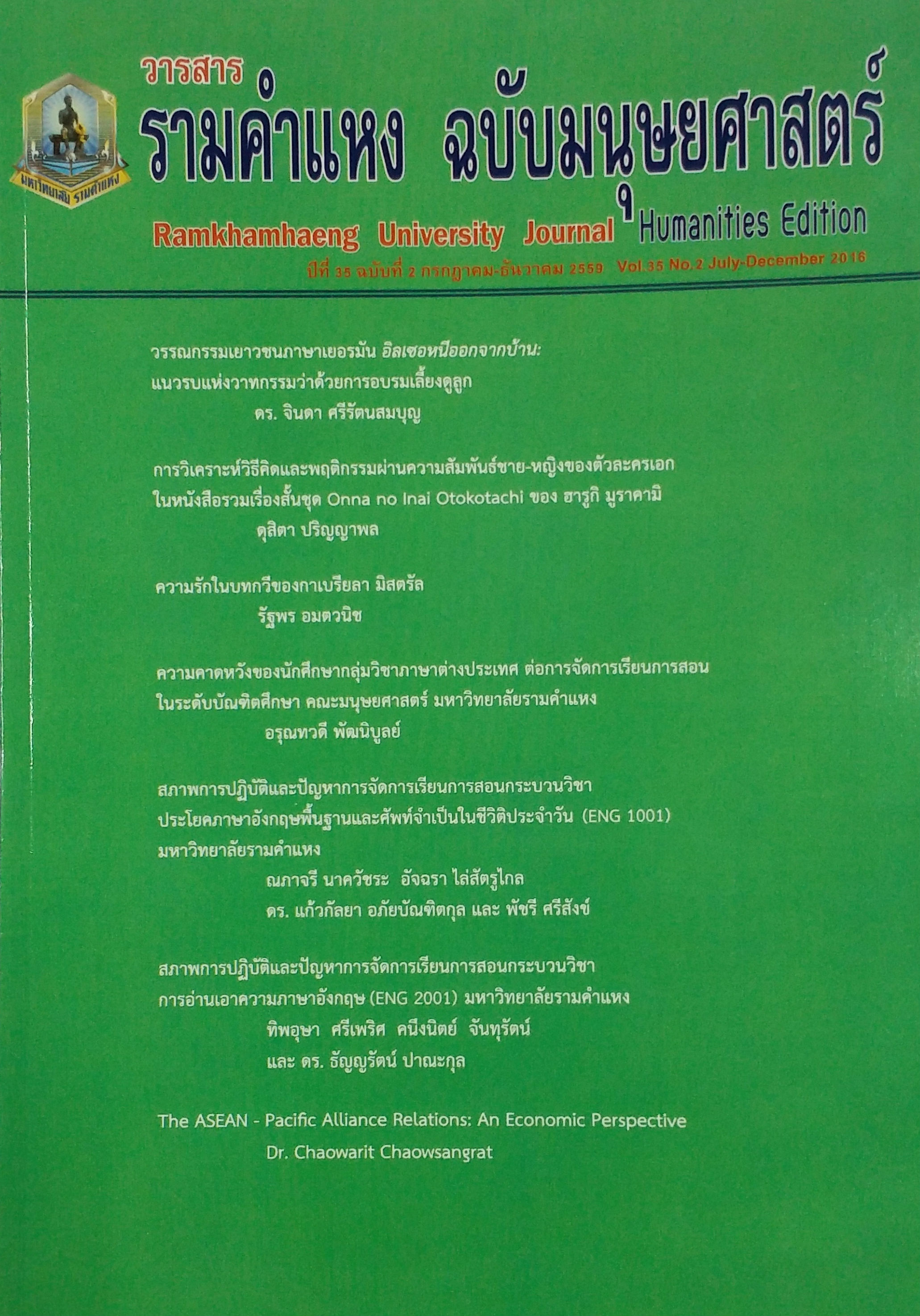การวิเคราะห์วิธีคิดและพฤติกรรมผ่านความสัมพันธ์ชาย-หญิงของตัวละครเอกในหนังสือรวมเรื่องสั้นชุด Onna no Inai Otokotachi ของ ฮารูกิ มูราคามิ Analysis of Ways of Thinking and Behaviors Through the Main Characters’ Male-Female Relationships in Haruki Murakami
Main Article Content
บทคัดย่อ
บทคัดย่อ
หนังสือรวมเรื่องสั้น ชุด Onna no Inai Otokotachi (เหล่าชายผู้ไม่มีสตรีอยู่เคียงข้าง-ผู้วิจัย) คือหนังสือรวมเรื่องสั้นทั้งหมด 6 เรื่อง ได้แก่ Doraibu mai kaa (Drive my car), Iesutadee (Yesterday), Dokuritukikan (อวัยวะอันเป็นอิสระ), Sheerazaado (ซาห์ราซัด), Kino (คิโนะ) และ Onna no Inai Otokotachi (เหล่าชายผู้ไม่มีสตรีอยู่เคียงข้าง) ซึ่งเป็นผลงานล่าสุดของฮารูกิ มูราคามิที่รวบรวมและตีพิมพ์โดยสำนักพิมพ์บุงเกชุนจู(文藝春秋)แล้วเสร็จในเดือนเมษายน 2557 และยังไม่มีการแปลเป็นภาษาไทย เรื่องสั้นชุดนี้มีเกณฑ์การวางทิศทางของเรื่องไปในทางเดียวกันทั้งหมด กล่าวคือ ผู้ชายซึ่งเป็นตัวละครเอกทุกตัวจะต้องเผชิญหน้ากับการสูญเสียหญิงคนรัก
การวิจัยนี้มีจุดประสงค์เพื่อศึกษาวิเคราะห์แนวคิดและพฤติกรรมของตัวละครเอกในการรับมือกับปัญหาดังกล่าว ว่าสะท้อนความจริงอันเป็นลักษณะเฉพาะทางวัฒนธรรมที่เป็นเอกลักษณ์ของสังคมญี่ปุ่นอย่างไร โดยใช้ทฤษฎีวัฒนธรรมญี่ปุ่น(日本文化論)ผลการวิจัยพบว่า การรับมือกับปัญหาดังกล่าวของตัวละครเอกชายมีแนวคิดที่เป็นจุดร่วมกัน คือ ภาวะการพึ่งพิง (อามาเอะ:甘え) การปิดกั้นตัวตนที่แท้จริงและสร้างตัวตนใหม่ (ทาเทมาเอะ:建前) และการไม่แสดงความต้องการที่แท้จริง (ฮนเนะ:本音) อันเป็นผลมาจากจิตสำนึกที่ต้องรับผิดชอบในหน้าที่ที่คนรักที่ดีพึงกระทำ (กิริ: 義理) ซึ่งถือเป็นแนวคิดที่เป็นจุดร่วมหลัก เนื่องจาก “กิริ” มีปรากฏให้เห็นชัดเจนในตัวบทครบทั้ง 6 เรื่อง โดยแนวคิดเหล่านี้ล้วนแสดงเอกลักษณ์ของ ชาวญี่ปุ่นบางประการอย่างชัดเจน
Abstract
Haruki Murakami’s latest novel entitled “Onna no Inai Otokotachi” - which can be translated as “Men without Women” - is a collection of his six short stories; Doraibu Mai Kaa (Drive My Car), Iesutadee (Yesterday), Dokuritukikan (Independent Organ), Sheerazaado (Scheherazade), Kino and Onna no Inai Otokotachi (Men without Women). The Japanese edition was published in April 2014 by Bungei Shunju publishing company and haven’t been translated into Thai yet. In each of these six stories, the main character is a man who has suffered from losing his lover.
The purpose of this study, based on “Theories on Japan” (Nihonbunkaron - 日本文化論), was to examine how male protagonist’s mindset and behaviors toward his circumstances reflect the Japanese cultural identity. The study indicated that those main characters from all short stories share some distinctive points in common as follows: the lack of self-reliance (Amae:甘え) the behaviors and opinions one displays on the surface or in public (Tatemae - 建前) and the contrast between a person’s true feelings and desires (Honne - 本音) affected by the sense of social obligation/duty (Giri - 義理) as a gentleman. These social values are still prevalent in the mind of Japanese people.
Article Details

อนุญาตภายใต้เงื่อนไข Creative Commons Attribution-NonCommercial-NoDerivatives 4.0 International License.
ประกาศลิขสิทธิ์จะปรากฏในเกี่ยวกับวารสาร ควรอธิบายสำหรับผู้อ่านและผู้เขียนว่าเจ้าของลิขสิทธิ์เป็นผู้เขียนวารสารหรือบุคคลที่สาม ควรรวมถึงข้อตกลงการอนุญาตเพิ่มเติม (เช่นใบอนุญาตครีเอทีฟคอมมอนส์) ที่ให้สิทธิ์แก่ผู้อ่าน (ดูตัวอย่าง) และควรให้วิธีการรักษาความปลอดภัยหากจำเป็นสำหรับการใช้เนื้อหาของวารสาร


